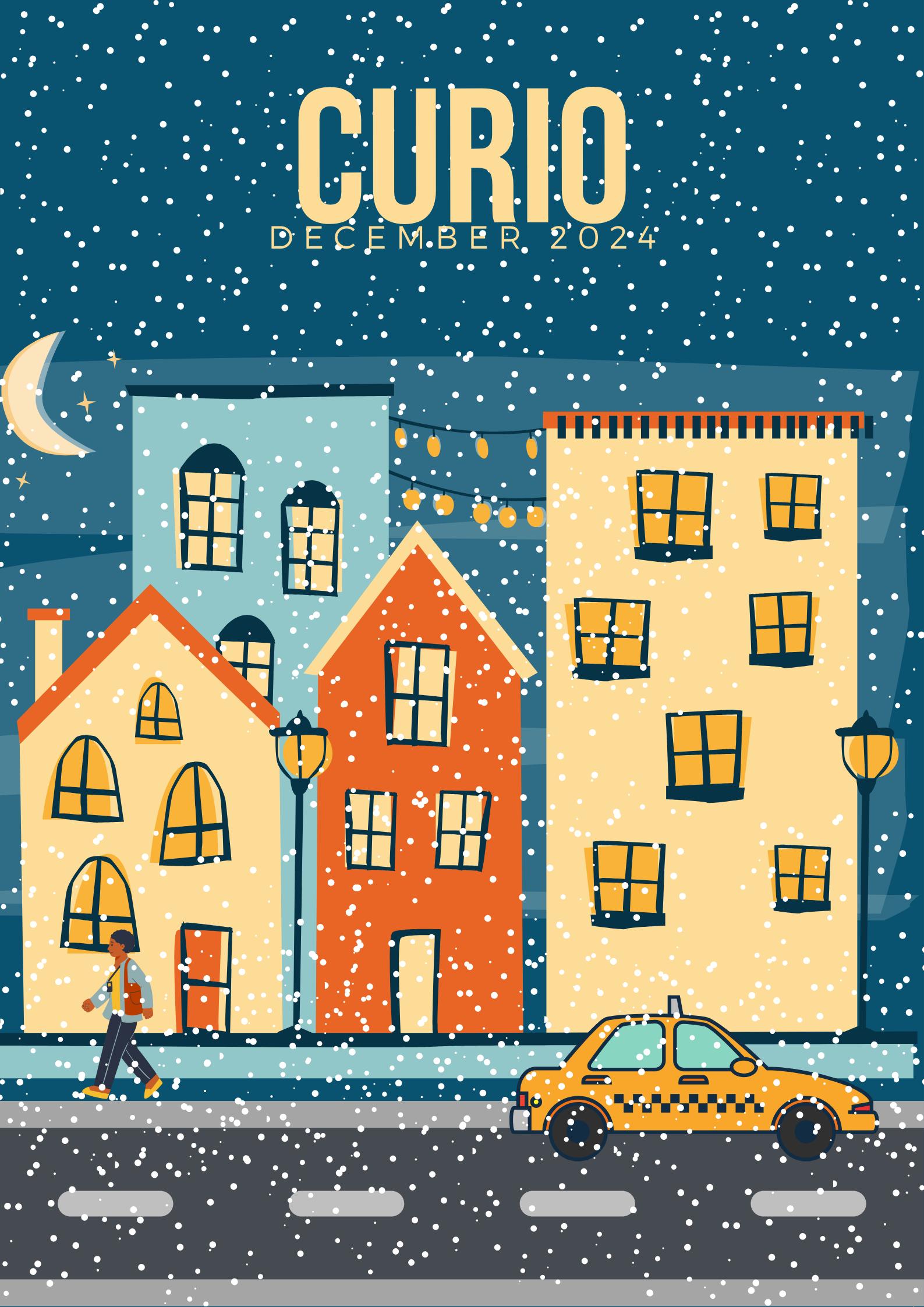

Editor’s Note
Dear Withingtonians,
As 2024 draws to a close and 2025 soon approaches, this time of year brings plenty of opportunities to reflect on changes, beginnings, and endings.
This half-term, we welcome a brand-new issue of Curio which contains reflections on the past as we ask, ‘How do musicals influence our view of the past?’ and go ‘Behind-the-scenes of Les Mis’, as well as acknowledgments of the future as we discuss the 2025 ‘Legally Blonde’ production.
Change may seem daunting as we reflect on all that has changed in the past year, and all that could change in the next. However, although making an abundance of ambitious New Year’s Resolutions may seem like the solution to cope with change, not all change can happen immediately as forced change is not always effective. In other words, slow and steady wins the race and, perhaps instead of rushing to change ourselves immediately, we should focus on finding a goal that we can work towards and simply let change happen along the way.
As a Fleetwood Mac song once asked, ‘Can I handle the seasons of my life?’, the response is, yes, you can.
The best things often require patience, and, for those of you who will be facing upcoming exams, remember to allow yourselves time to relax and recover alongside revising- and good luck!
Please relax and enjoy this issue of Curio.
Your editor,
Faye Davies
What Does Celebrity Culture Say About Society?
By Faye Davies
This time of year sparks the annual return of reality TV shows such as Strictly Come Dancing and I’m a Celebrity, Get Me Out of Here which rely on celebrities to form their cast. However, despite the claim that these ‘celebrities’ are recognizable to the public, ironically, most of the time they reach the height of their stardom after appearing on these shows, and, often, their appearance on these shows is what their fame becomes attributed to. This sparks the debate of what classifies a ‘celebrity’ today and whether celebrities do have ‘fame’ nowadays.
The etymology of the word ‘celebrity’ comes from the word ‘celibritatem’ in Latin, meaning the state of being busy or crowded; however, ‘fame’ is defined as the state of being known or recognized by many due to notable achievements or skills. This would suggest that, despite the idea of ‘celebrities’ and ‘fame’ being interactive, many celebrities nowadays gain this title before becoming famous, leading them to become household names even though most people would be unable to recall the occupations that made them famous. So, while fame is supposedly won by right as a reward, the status of a celebrity remains transactional and fluid and there is an increased oversaturation of celebrities in the media today.
Whilst a celebrity is a seemingly contemporary concept, the earliest known use of the term dates to Middle English (1150-1500) and it was most frequently used in the 1820s until it underwent a sharp decline before regaining traction in the 1980s. This disproves the commonly held idea that celebrities are a recent societal construct as it is only the word that had gone out of fashion. Celebrities have been prominent figures in society for as long as humans first discovered fire; they have just existed in a different way than we would expect.
A prevalent point that sparked a change in how famous people were viewed was the execution of Charles I in 1649. Before this, monarchs were the most famous people in English society, primarily due to religion and the idea that they were sacred and ordained by God. However, Charles’s execution brought about a significant societal shift and there became a wider acceptance that fame could be attributed to non-royal members of society and that it could be self-made. A couple of decades later, in the regency era (1811-1820), the widely accessible publication of personal affairs and gossip in high society, particularly London, allowed people to form opinions on some members so that they became widely renowned. This idea has even become the inspiration behind the popular Netflix show, Bridgerton, today. These


prominent individuals began to promote themselves using bribery to forge a positive public image in newspapers and forms of entertainment. This concept of orchestrating a desired public image was not new and had been used by monarchs for centuries such as Elizabeth I who would commission portraits of herself that would be filled with subtle details that would represent the beliefs she wanted to project. Nowadays, celebrities use similar methods of expression in the form of fashion and social media.
In the Regency era, writers and stage performers grew in fame due to the commercialization of literature and the popularity of theatre as a form of entertainment. An example of a celebrity formed from this is Elizabeth Farren who became famous as an actress in the late 18th century. In this case, Farren’s fame worked out extraordinarily well for her as she attracted the eye of a wealthy aristocrat and, by refusing to be his mistress, he then proposed, and she became a countess instead!
Throughout history, famous people have reflected the changes within our society as it is ultimately all members of society that decide what personas we would like to praise. In the 1880s, celebrities included politicians, scientists, and doctors whereas in the 1920s, singers and actors became admired due to the invention and widespread popularity of film. Whilst these professions are still extremely valued in society, the emergence of new types of celebrities like influencers suggests that societal shifts are occurring. Celebrity culture is a debate about whom and what we value and, as we enter a period of escapism, influencers and reality TV stars are boosted into the limelight as we attempt to live vicariously through them.
However, this has also led to dangerous new developments such as ‘cancel culture’ due to the realisation that it is the public that has the power to give people fame, whilst also having the power to strip that fame away. Cancel culture is derived from society’s desire to observe a perfect person. A person who is candid and yet doesn’t offend anyone, doesn’t make mistakes and most certainly doesn’t have opinions or emotions. They need to be flawed in a way that makes them relatable yet not so flawed that they become real human beings. In our search for ‘normal’, we seem to have forgotten that ‘normal’ applies to everyone and that celebrities have the same set of emotions that we do. It becomes increasingly difficult to tell fact from fiction and perhaps we should remember that mistakes are an inevitable part of the human experience and stop placing people on a pedestal, no matter what their net worth is.
Whilst celebrity culture has become an integral part of our society, we mustn’t model our values around them. Instead, we should ensure that we maintain a grasp on reality, not reality TV stars.
How Musicals Influence Our View of the Past
By Dhaani Singh
What do you think of when you hear the term ‘historical musical’? Maybe it's the hiphop beats of Hamilton, showing the story of a Founding Father through a modern gaze, or Six, where Henry VIII's wives reclaim their stories through catchy songs. These musicals, and many others like them, do more than simply entertain; they bring centuries-old events to life and make them engaging and relevant. They retell history to bold music, giving audiences a new, captivating way to relate to the past. But in doing so, how much do they alter our view of historical events?
The legacy of Hamilton
Musicals, by their very nature, are supposed to entertain, but often at the cost of historical accuracy. Hamilton accurately portrays Alexander Hamilton's rise in American politics, his contributions to the Federalist Papers, and some very complicated relationships, particularly those involving figures such as George Washington and Thomas Jefferson, to name a few. Yet, the musical takes liberties, simplifying his affair with Maria Reynolds and intensifying certain motives for dramatic impact. It highlights Hamilton's abolitionist views yet doesn’t mention his ties to slavery through his marriage into the Schuyler family. The Schuyler family were major slaveholders with over 40 enslaved people in their Albany mansion. These minor missed-out details risk giving audiences a one-dimensional view of Hamilton, A view shaped by Lin-Manuel Miranda, the author of Hamilton.
Six: History with a modern twist

Six, on the other hand, takes an even more playful approach with its retelling of the lives of Henry VIII’s wives. While the basic stories and order of the wives are accurate such as Catherine of Aragon being his first wife and standing by her Catholic faith and Anne Boleyn being executed on charges of adultery, the musical uses modern language and pop music to reframe these women’s stories. The show’s format as a pop concert allows each wife to give her own perspective, which helps humanise them and allows them to voice their unique struggles and personalities.

But Six also takes liberties that alter the historical narrative. Anne Boleyn’s portrayal as

a rebellious ‘bad girl’ simplifies the complex political motivations behind her downfall. Anne’s outspoken manner gained her much dislike from people who were unaccustomed to an opinionated Queen. Her influence on Protestant Reforms challenged traditional Catholic establishments and placed her in opposition with powerful people such as Thomas Cromwell, who saw her as an obstacle to his political aims. The accusations of adultery, incest, and treason against her were exaggerated, thus providing a convenient reason for her execution. Her execution was due to the complex political and religious issues attributed to Tudor England, not just because of her rebellious character portrayed in the musical.
In Six, the wives of Henry VIII are portrayed as having a playful rivalry with each other, but most of them never actually met. Jane Seymour is presented as sweet and innocent yet this one-dimensional view of her fails to show her complexities and the challenges that she endured throughout her time at court. While these inaccuracies are understandable in a musical intended first and foremost to entertain, they remind the audience that the ‘girl power’ narrative framing the show is a modern reinterpretation rather than a historical reality.
Creative freedom vs historical accuracy
Hamilton and Six use historical facts and creative storytelling to engage their audience. They touch on many issues which are still relevant today, but even though someone may be mesmerised by the catchy songs and interesting stories, they are not replacements for historical research. This combination of fact and fiction brings life to history but, at the same time, requires audiences to determine the instances where entertainment prevails over historical accuracy.
Entertainment sparks curiosity
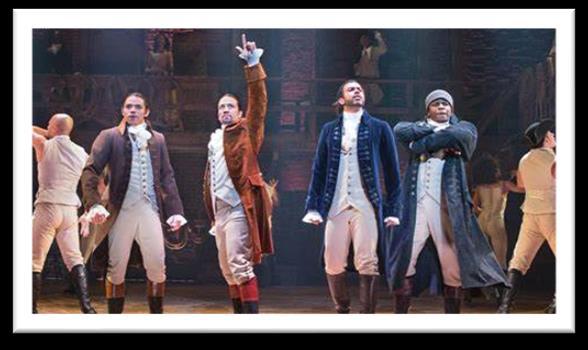
Though musicals aren’t meant to be history lessons, they often spark interest in the topics which they portray. An audience member might leave the theatre eager to learn more about the real Alexander Hamilton or Anne Boleyn. These shows create a bridge to the past, opening the door for people to dig deeper into the historical truths behind the fiction. Musicals make history accessible and exciting, even if they’re not entirely accurate. Ultimately, while historical musicals may not be a perfect reflection of the past, they breathe new life into history and make it feel personal and relevant, entertaining and educating people simultaneously.
Where Did Renewable Energy Begin?
By Jasmine Meftah
The UN states that “Renewable energy is energy derived from natural sources that are replenished at a higher rate than they are consumed. Sunlight and wind, for example, are such sources that are constantly being replenished. Renewable energy sources are plentiful and all around us.”.
Around 200 BC, there was a simple form of renewable energy waterwheels. Waterwheels mimic the workings of hydropower which is a source of renewable energy that generates electricity by using structures like dams and reservoirs to change how water naturally flows. Waterwheels can convert the energy generated from the moving water into other forms of energy, such as mechanical or electrical energy. They do this through a circular motion enabled by a rotating shaft.

Windmills were crucial in the development of renewable energy as they demonstrated how mechanical energy can come from natural resources, and therefore presented the idea that there was a better way than to burn fossil fuels. During the 1590s, the popularity of windmills reached its peak. Although windmills are far from the advanced technology of wind turbines today, this traditional technology has influenced modern wind turbines. Wind turbines work due to wind pushing the blades on the windmill which causes a rotating movement in the rotor shaft. Their main use in the 1590s was to pump water and mill grain.

The generation of energy using solar cells (are a device that converts sunlight directly into electrical energy using the photovoltaic effect) was demonstrated to a board of professors by William Grylls Adams. Adams did this by showing how selenium cells, which are technically a kind of solar cell but are not used commonly nowadays, could absorb rays from the sun and generate electricity. In 1887, wind turbines were finally built and were gaining more interest across Europe, thus leading to 341,320 wind turbines being in operation around the world by 2016.

In 1905, Einstein examined how light cells carry energy that could be used to power buildings. This was called the photoelectric effect which describes the emission of electrons when light shines upon certain materials. Despite Einstein perfecting the
photoelectric effect, Edmond Becquerel had previously discovered this in 1839 during his experiments on the effects of light and how it interacts with electrolytic cells.
Summary of few key events that had happened during the 20th and 21st century:
In 1927, wind turbines went commercial.
In 1935, the Hoover Dam was built and put in place to provide water for Southern California and Arizona efficiently, allowing a steady water supply. It was the largest hydroelectric facility in the US at the time and it cost $165 million to build.
In 1958, solar energy went to space, as the first US satellite used solar energy as a power source.
In 1978, an entire village went solar the Tohono O’odham Reservation in Arizona.
In 1996, a solar project called Solar 2 (one of three solar power plants located in the Mojave Desert) found a more cost-effective way of storing energy. Instead of using oil or water, they used a combination of sodium nitrate and potassium nitrate. This allowed energy to be stored for longer periods, especially when clouds blocked the sunlight.
In 2013, the Ivanpah Solar Power Facility, the world’s largest concentrated solar power plant, was built in California’s Mojave Desert.


To conclude, from the earliest applications of renewable energy, including wind, hydroelectric, and solar energy, to modern technology that helps reduce the usage of non-renewable energy, the historical usage of renewable energy shows how humans have always worked with natural energy sources. This reflects the demand for creativity and necessity of sustainable solutions to meet our energy demands. Renewable energy has continuously evolved to meet the frequent changes and technological advancements. From early windmills to solar panels and wind turbines, the broad range of renewable resources used from the past to present shows us that we can rely on sustainable energy.
Hoover Dam
Solar power plants in the Mojave Desert
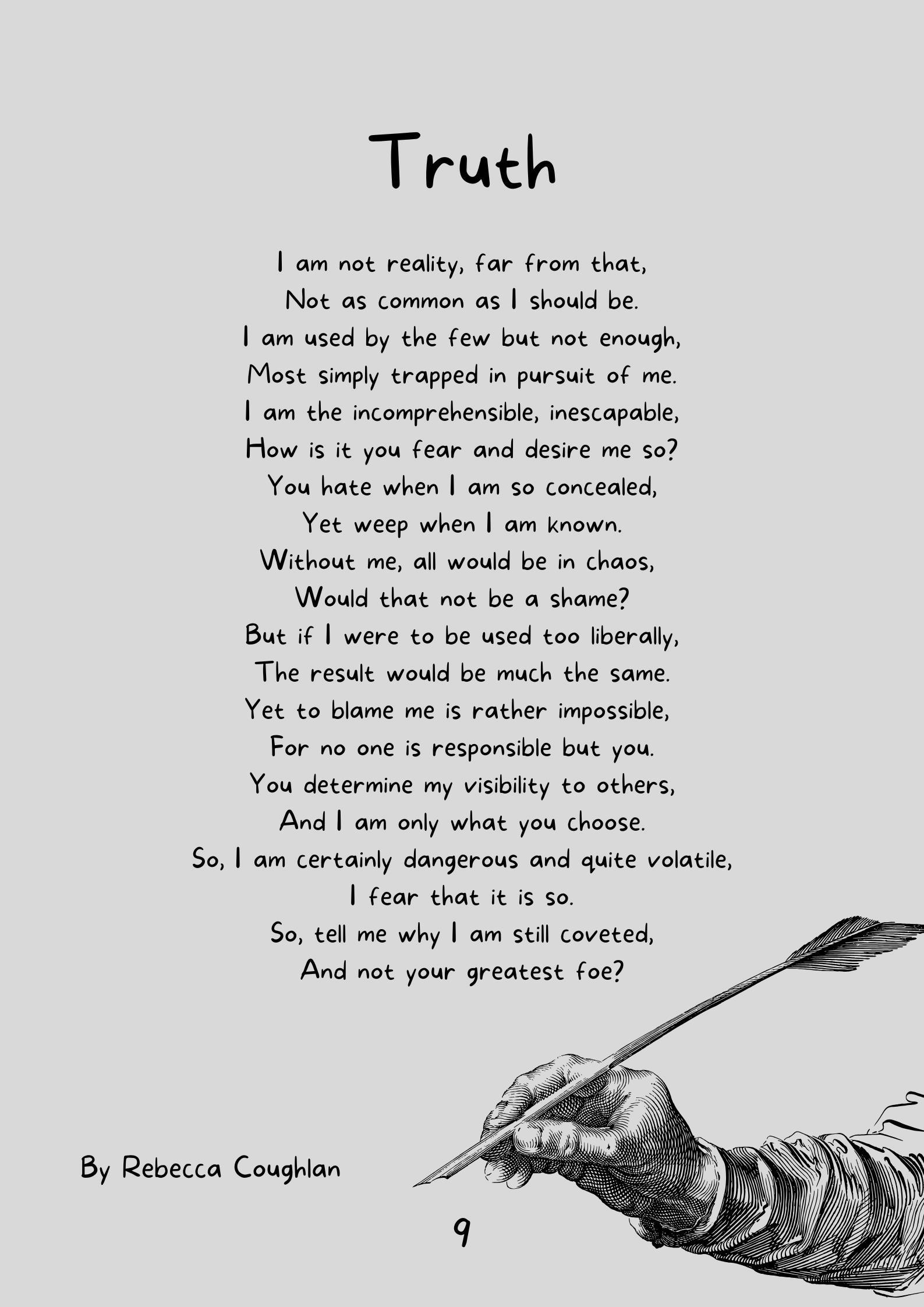
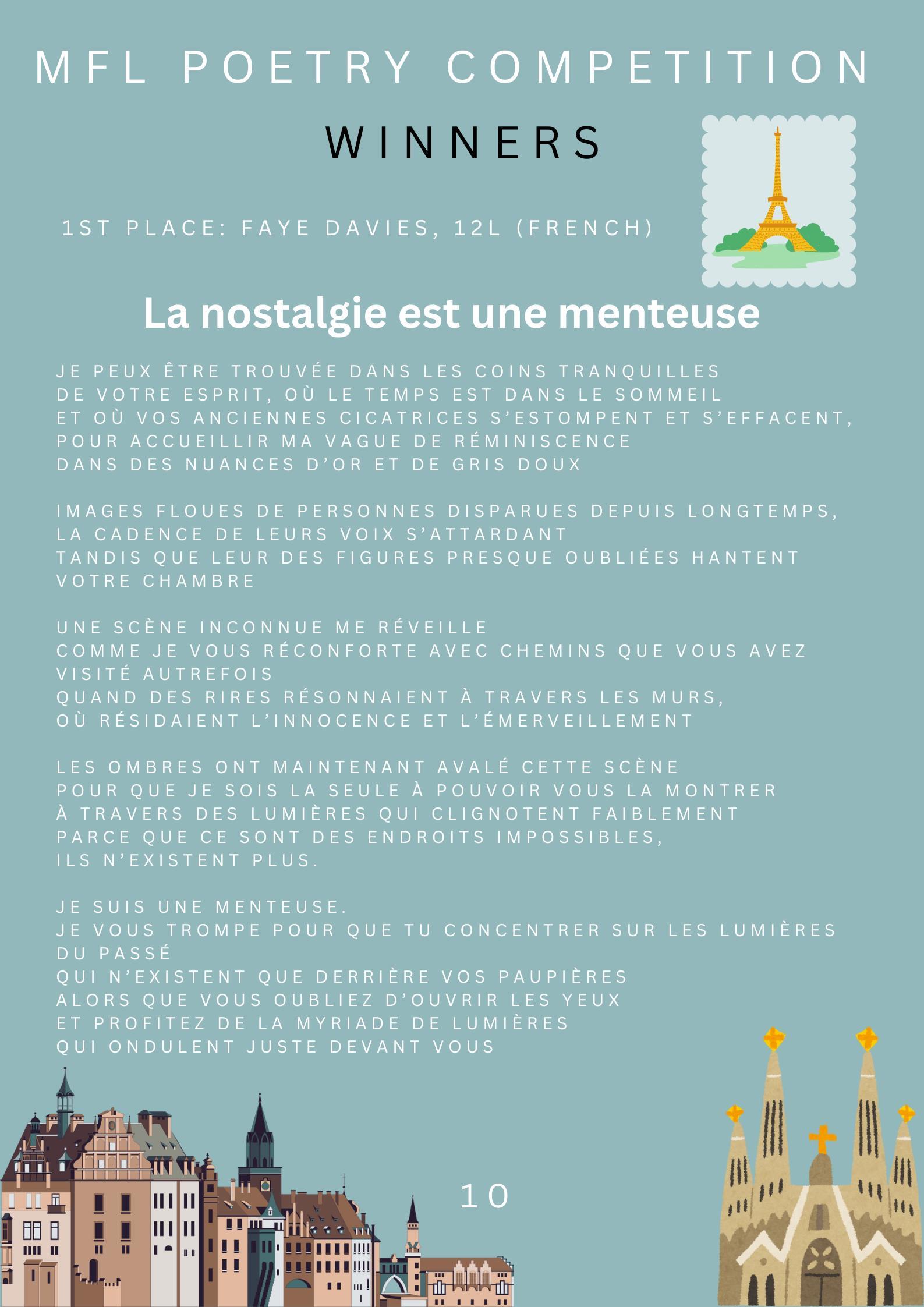


OMIGOD YOU GUYS!
The school musical is back- and it’s bigger and blonder than ever.
Following last year’s show-stopping performance of Sister Act, the drama department will be retiring their habits and donning considerably more pink in preparation for what is sure to be a spectacular production of Legally Blonde in the summer of 2025.
Legally Blonde: The Musical is a 2007 musical adapted from the novel and 2001 film of the same name. The storyline follows Elle Woods, a sorority girl who enrols in Harvard Law School, initially to win back her ex-boyfriend. However, she gradually discovers her passion and skill for helping others by using the law, defying other people’s misguided expectations of her whilst remaining true to herself and maintaining her positivity and empathy.
Find the cast list below (NB the list below does not include all members of the Principal Ensemble, Company and Advanced Dancers):
Elle Woods: Florence Hannaby Cummins, Meira Narayan
Emmett Forest: Calista Lam, Rosie Wallis
Paulette: Orli Garnett, Ciara Halpenny
Brooke Wyndham: Lily Nguyen, Ava Robinson
Kate: Emily Edge, Alice Fines
Vivian Kensington: Poppy Winnard, Ally Ng
Warner Huntington III: Eilidh Milner, Anushka Krishnan
Professor Callahan: Sofia Dhawahir-Scala, Anika Ramesh
Margot: Chloe Woolf, Sonia Amonkar
Serena: Margi Javle, Annabel Mayo
Chutney Wyndham: Eden Hamilton, Ruby King
Pilar: Cara Mooney, Betty Dewsnap
Gaelan: Tenesha Swarbrick, Serena Omeje
Saleswoman: Fifi Johnstone, Lucinda Ong Shanks
Store manager: Safiya Raj Pura, Phoebe Xu
Grandmaster Chad: Abigail Snarr, Rose Codling
Winthrop: Nanaki Singh, Adhyavi Gupta
Lowell: Dhaani Singh, Margot Tatton
Pforzheimer: Sophie Forster, Aarya Jairath
Jet Blue Pilot: Hai-Yee Fan, Wenqi Zhang
Aaron Schultz: Rani Kumar, Eldan Bokre
Sundeep Agrawal Padamadan: Sadie Horwich, Sofia Vega Hildago
Enid Hoopes: Farah Aldawoud, Elspeth Hill
Whitney (Paulette's friend): Anaya Madhav, Rushani Gokulan
Dewey: Ellie Bayes, Ruby King
Prison Guard: Aaloka Ariyawansa, Saleha Malik
Kyle: Clara Wilkinson, Poppy Button
Kiki the Colorist: Marike Viljoen, Lucy Brown
Cashier: Harbaani Sachdev, Ally Ng
Stylist: Tannistha Ganguly, Poppy Winnard
Bookish Client: Eve Cooper, Inaaya Khatri
Judge: Sana Sarkar
Bailiff: Diema Sabi
Bruiser: TBC

Behind the scenes of Les Mis!
By Eilidh Milner
This October, I was lucky to be a performer in the ensemble of Manchester Grammar Schools’ musical production of the popular stage show and novel, Les Misérables. This production was an incredible success, with students from MGS, Man High and Withington performing for 3 sold out nights at the MGS theatre. I interviewed a small group of fellow cast members from MGS, Man High, and Withington about their experience being part of such a special show.
Interviewer: Who do you play in Les Mis?
Deryn: Prostitute 4 and girl 4, and chorus member
TJ: Old Woman, girl 1, woman 1, and worker 1 and 2
Eryk: Everyone
Alice: Eponine
I: How did you find balancing schoolwork and rehearsals/performances?
D: There were a lot of rehearsals, but my teachers helped me with extensions
T: Very very easy
E: I found the rehearsals schedule very manageable
A: I came to rehearsals throughout my GCSEs and still got grades I was happy with. It’s possible to balance
I: What has been your favourite moment of the production?
D: Backstage on show week
T: Performance, backstage of performances
E: The first dress rehearsal on the Monday
A: Opening night was so much fun
I: What one word would you use to describe Les Mis?
D: Long
T: Experience
E: Sensational
A: Extraordinary
Members of the audience have described the show as:


“Incredible, West End quality”


“It was amazing what was achieved in a relatively short rehearsals period, and difficult to comprehend that the performers are only school-aged”
“Loved seeing the friendships formed across all three schools”
“Certainly, one of the hardest musiCals to perform as it’s almost an opera. Very hard musiCal sCore”
“Outstanding, the hard work and talent was showcased to invoke an emotional response and instil a sense of pride”
Films to enjoy this winter
By Meerab Fatima
There is no season quite like winter that’s perfect for snuggling up with a wonderful movie to enjoy along with a steaming mug of tea or hot chocolate, a bundle of warm and cozy blankets, a fireplace nearby and plenty of snacks. I’ve put together a list of 7 great films to watch this winter (or any season, for that matter), some with heavy winter and Christmas themes, and some that were simply too good not to include. Whether with family, friends, or alone, I hope you can enjoy some of these films soon!
Eternal Sunshine of The Spotless Mind
Imagine being able to erase your memories of someone completely, leaving you with a mind that is spotless free of them. Michel Gondry explores this exciting and terrifying idea in this wintery film filled with love, heartbreak, and a lot of pain. Eternal Sunshine of The Spotless Mind will, no doubt, pull at your heartstrings as it follows the story of a complicated relationship starring Jim Carrey and Kate Winslet. The film shares a poignant message about the nature of love, memory and regret in an immensely creative way. Aside from the heartfelt story, the entire film is beautiful. From the cinematography, the captivating shots, and scenery, to the surreal comedy and clever writing, it is an undeniably wonderful film.
Dead Poets Society
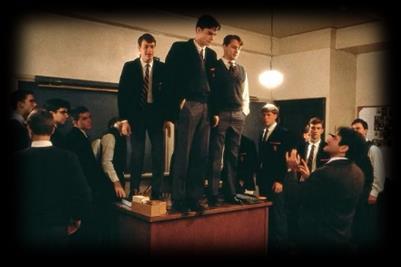

Carpe Diem. Seize the day. A passionate English teacher encourages his students at an elite all-boys boarding school to pursue their own passions and rebel against convention, leading to a journey of selfdiscovery, friendship, woes and joy for a group of young men. The winter setting and youthful nature create such a wonderful, cozy atmosphere to the film while still being incredibly meaningful and, I’ll admit, rather heartbreaking at times. It’s the kind of film that has you rooting for each individual character more and more as it goes on and will stick with you for a while.
Home alone
It goes without saying that Home Alone (1 and 2) is a classic Christmas film that is loved universally; it is funny, entertaining and nostalgic in all the right ways, showcasing everything magical about Christmas. It is a comfort movie at its core, wonderful for getting cozy while it’s cold outside with family and friends – how could it not be on this list? I’m sure, watching Kevin’s chaotic childhood antics, we can agree that Home Alone will never get old.
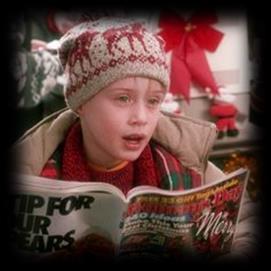
12 Angry Men

This film isn’t related to Christmas or Winter at all, in fact, it’s set in the depths of summer. Guilty! But it was simply too good not to include. 12 Angry Men might be one of my favourite films of all time, and I would whole heartedly recommend it to anyone. A classic from the 1950’s, it is, in essence, exactly as the title suggests...12 angry men. Really, the entire film is 12 men angry with each other and arguing in a courtroom. The jury is to decide if a young Spanish-American man is guilty or innocent of murdering his father, and, with the process, each man’s personal character, views and decisions are explored, each vastly different. Despite being mostly dialogue, the framework and shots do a great job of keeping you captivated, and the entire film is so interesting and ahead of its time. No matter the season, it is a must- watch.
It’s a Wonderful Life

Another classic, though this one is, of course, very Christmasy. It’s a Wonderful Life is a wonderful film, that follows the suicidal George Bailey who, with the help of an angel, realises how many lives he has impacted and changed, and the travesty the world would become without him. This film is genuinely moving from beginning to end, we inevitably end up connecting, sympathising, and rooting for the main character from his greatest achievements to his largest failures and pitfalls. It is the perfect mix of heartwarming moments, dread, humour and ultimately an extremely meaningful message that makes this film extremely difficult to not like. It truly is wonderful.
My Neighbour Totoro
I couldn’t resist putting a Studio Ghibli film on this list. Though it is neither a Christmas nor winter film, My Neighbour Totoro is immensely comforting. It’s a heartwarming slice of life set in the countryside with some magical elements and spirits that will undoubtedly evoke the inner child in you. The art and animation in this film are what truly make it so healing and simply lovely, mesmerizing you with its vibrant and nostalgic feel. Unlike most of the other films on this list, it’s not immensely plot heavy, but worry not – relax and let its magic immerse you into its wonderful world.

That's all for now. I hope you can sit back, relax, and enjoy some films this winter - as a break from school, mocks, exams, or to simply enjoy.
Recipes from Baking Club
By Vivian Tran and Rafaella Ingleby-Castleton
Baking Club has been introduced this year at Withington and is available to anyone in Years 10-13 who wants to improve their baking skills, have fun with friends, or simply take some time away from the stress of GCSEs and A-Levels. The club runs on a 3-week rotation (Year 11 in November, Sixth Form in December, and Year 10 in January) on a first come first served basis as there is a limited number of spaces available. Do not worry if you have missed the Year 11 block this November or will not be able to attend future sessions if you are in Year 10, 12, or 13, as all recipes that we have done are all written below. We hope to see lots of you at future sessions!
Week 1: Flapjacks
Prep time: 5 minutes
Bake time: 25 minutes
Total time: 30 minutes
Serves: 16
Ingredients:
225g unsalted butter
150g golden syrup
150g soft light brown sugar
450g oats
1tsp salt
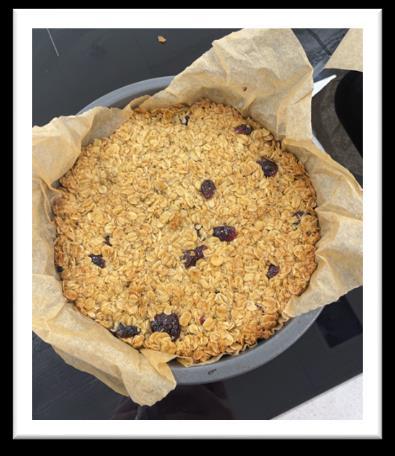
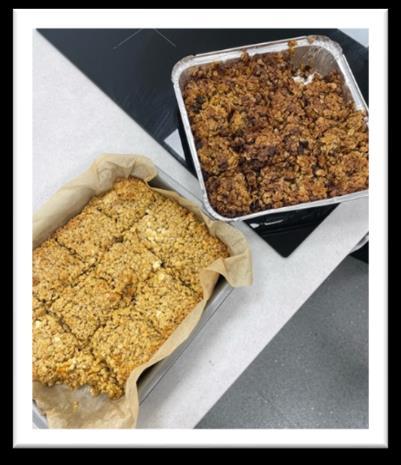
+ additional ingredients: chocolate chips, dried fruit, etc.
Recipe:
1. Preheat your oven to 170C.
2. Line a 20×20 cm baking tray with baking parchment.
3. Melt your butter, sugar, and golden syrup in a large pan over a low heat. Once the sugar has dissolved, remove from the heat and stir in the oats and salt.
4. Give the entire mixture a good stir so that all the oats are coated.
5. Pour the mixture into your lined baking tin and pat down with the back of a spoon.
6. Bake in the oven for 20 minutes. (The edges should be starting to brown but the middle should still be soft and wobbly.)
7. When the flapjack is cold, remove it from the tin and slice your flapjacks into 16 squares with a sharp knife.
8. Enjoy with drizzled chocolate on top!
Week 2: Cookies
Prep time: 5 minutes
Bake time: 5 minutes
Ingredients:
110g unsalted butter
150g light brown sugar
115g granulated sugar
1 large egg, room temp
1tsp vanilla extract
200g plain flour
1/2tsp bicarbonate of soda
1/2 tsp salt
200g chocolate chips
Recipe:
1. Preheat oven to 190C
2. Line baking tray with parchment paper
3. Melt butter over a small pan on medium heat
4. Once butter has cooled, pour into a large bowl
5. Add light brown sugar and granulated sugar, whisk until fully combined
6. Add one large egg and vanilla extract, whisk until combined
7. Add plain flour, bicarbonate of soda, and salt, mix to form a dough.
8. Mix in chocolate chips and any extra fillings, fold through the mix until fully combined.
9. Scoop dough into balls onto lined baking tray and bake in the oven for 5-6 minutes.

Week 3: Rocky Road
Time: 20 mins
Serves: 12
Ingredients:
200g digestive biscuits
135g butter
200g dark chocolate
2-3 tbsp golden syrup
100g mini marshmallows + extra fillings
Recipe:
1. Grease and line a square baking tin with parchment paper.
2. Break/crush biscuits into large chunks. Set aside.
3. In a large saucepan melt butter, dark chocolate and golden syrup over a gentle heat stirring constantly until there are no or almost no more lumps of chocolate visible, then remove from the heat. Leave to cool.
4. Take the biscuits, mini marshmallows, and additional filling, if you like, and stir into the chocolate mixture until everything is completely covered.
5. Tip the mixture into the lined baking tin and spread it out to the corners. Chill for at least 2 hrs.
6. Dust with icing sugar and cut into 12 squares.


Langsoc round-up
ByFayeDavies
Langsoc is the new language society that began in September of this year and is welcome to all pupils from years 7-13. If you have an interest in languages or just a general interest in learning, Langsoc runs every other Wednesday with talks about languages that aren’t on the school curriculum such as Mandarin and Swahili as well as inquiries into language itself such as ‘can we think without language?’
This half-term saw talks about Scottish Gaelic from Eilidh and Japanese from Starlett in Year 11. Eilidh began her talk by telling us about the origin of Scottish Gaelic which is mostly spoken in the Outer Hebrides and was believed as being brought to Scotland by Irish settlers in the early Middle Ages. The language reached its social, cultural, and political peak in 1018 AD and the majority of modern Scotland once spoke it fluently. However, the percentage of native Scottish Gaelic speakers has steadily declined since the late 11th century when a non-Gaelic-speaking King took over Scotland. There were further attempts to eradicate Gaelic as it was outlawed in 1609-1610 and 1616 due to Jacobean uprisings and conquest by the English. Contrary to popular belief, Scots is not the same language as Scottish Gaelic, and, today, reports have found1.5 million speakers of Scots in Scotland whilst there were only 130,000 people with basic skills of Gaelic, therefore emphasizing the importance of learning and encouraging others to learn the language and protect its heritage.

Starlett introduced us to Japanese, which was certainly very different, geographically and phonetically, to Scottish Gaelic. Japanese uses the Kana systems (Japanese writing systems) of Hiragana for the phonetic lettering used in words as well as Katakana which is used for onomatopoeia as well as the translation of foreign words into Japanese. Many Japanese words were derived from English and other European languages such as ‘apāto’, derived from ‘apartment’ in English, ‘tenshon’ from ‘tension’, and ‘karaoke’ from ‘kara’ (empty) in Japanese combined with ‘orchestra’ in English. Starlett also introduced us to Japanese honorifics which are gender-specific suffixes placed at the end of names. There are a range of different suffixes which refer to the level of the speaker’s social status as well as an individual’s relationship with the speaker. These honorifics include ‘san’ which is the most universally used honorific and is often translated as ‘miss’, ‘Mr’, ‘Ms’ or ‘Mrs’, and ‘kun’ which is generally used to address a person of more senior status. The honorific system originated due to the ancient Japanese belief system that, if you knew someone’s name, you could take control of them.

Next half-term in Langsoc, there will be a talk given in January on Afro hair among many other language-based talks from cultures and countries around the world.

